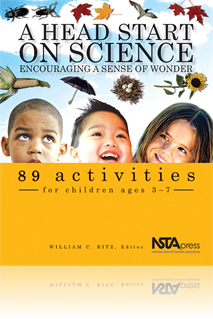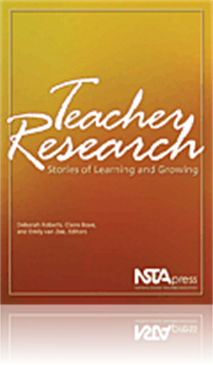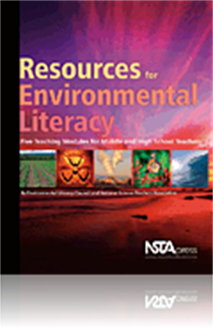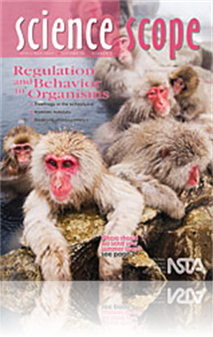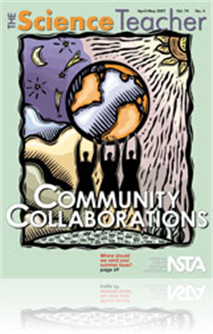All Resources
Journal Article
The after-school science club at Galtier Math, Science, and Technology Elementary Magnet School in St. Paul, Minnesota, learned some valuable lessons when they took newfound knowledge about pollution into their homes. After learning about the effect...
eBook
A Head Start on Science: Encouraging a Sense of Wonder (e-Book)
For the littlest scientists, the whole wide world can be a laboratory for learning. Nurture their natural curiosity with A Head Start on Science, a treasury of 89 hands-on science activities specifically for children ages 3 to 6. The activities...
Book Chapter
How Can Playing With a Motion Detector Help Children Learn to Write Clear Sequential Directions?
Kathleen Dillon Hogan is a kindergarten teacher in the Calvert County, Maryland, public schools. When this paper was written, she was a first-grade teacher at Hyattsville Elementary School in Hyattsville, Maryland. Kathleen heard a colleague describe...
Book Chapter
This curriculum, A Head Start on Science, was written to help adults facilitate young children’s learning as they work as partners to explore their world. This complimentary Introduction serves as a navigational tool for early childhood teachers ...
Book Chapter
Introduction: The Environmental Context
The argument for teaching science in the environmental context is based on the reality of the science-environment relationship and on the potential that contextual teaching has for contributing to valuable student learning. At the same time, it must ...
NSTA Press Book
Genetically Modified Crops: Resources for Environmental Literacy
Supporters of genetic engineering point to the potential of genetically modified (GM) crops to improve human health and increase environmental protection. But some concerned groups argue that the risks of GM crops may outweigh their benefits. These g...
NSTA Press Book
Radioactive Waste: Resources for Environmental Literacy
Since World War II, hundreds of thousands of tons of radioactive materials have been produced in the United States. How we will dispose of nuclear waste is a controversial issue with a large technical component. This book provides a useful resource...
By Environmental Literacy Council, National Science Teachers Association (NSTA)
Journal Article
The Case Study: Using a Case-Study Article to Effectively Introduce Mitosis
Community college students in a nonmajors biology class are introduced to mitosis by reading a case-study article that allows them to gauge how many times various parts of their bodies have been regenerated. The case-study article allows students to ...
Journal Article
Students, faculty, and advisers must have ready access to current, accurate, and useable information about programs and curricula (Commission for Undergraduate Education 1995). College and university publications (e.g., bulletins, catalogs, schedul...
Journal Article
A large enrollment, instructor-centered chemistry course taught with science demonstrations was transformed into one that was more student-centered. Course survey and examination results revealed more positive perceptions of the benefits of demonstra...
Journal Article
According to Carl Sagan (1987), “Science is a way of thinking much more than it is a body of knowledge.” Field studies and undergraduate research provide students with the best opportunities for thinking about science, while at the same time acqu...
Journal Article
Every science major has prerequisites: algebra, calculus, general chemistry, or introductory physics. As faculty, we understand the importance of these foundation courses. After all, we establish these prerequisites or, at least, review their utility...
Journal Article
In this month’s article, the editor discusses her observations regarding the lack of participation from her intellectually mature freshman class. However capable and accomplished they were, these young people didn’t seem to know how to advocate f...
Journal Article
Favorite Demonstration: The Nature of Color Subtraction: A Guided Inquiry Experience
Many college students profess to have an understanding of the nature of color. The study of color begins in the early grades, so it makes sense that students should feel confident regarding their knowledge. However, oral questions to probe understand...
Journal Article
Is Collaborative Grouping an Effective Instructional Strategy?
While problem solving is a generally accepted goal of most science courses, it has previously been difficult to determine the extent to which students’ problem-solving abilities are impacted by these courses. Interactive Multi-Media Exercises (IMME...
Journal Article
A Professional Development Teaching Course for Science Graduate Students
Although the majority of the teaching faculty at U.S. universities is composed of people who are scientific experts, research has found that most scientists do not have information about effective teaching methods (DeHaan 2005). Traditional lecture-s...
Journal Article
A Simple Approach to Improving Student Writing: An Example From Hydrology
Using the simple approach described in this article, college science instructors can help students become independent thinkers and writers in science. The unique character of this approach is that it shows students how to formulate the questions they...
Journal Article
Society for College Science Teachers: Teach for Understanding Before the Details Get in the Way
Several studies (Bruner 1996; Wiggins and McTighe 1998) have revealed that the teaching methods in college science classrooms often encourage students to memorize rather than comprehend. Too often, precious teaching time is spent going over details, ...
Journal Article
Meaningful Involvement of Science Undergraduates in K-12 Outreach
The authors argue for the involvement of science undergraduates in K–12 outreach to enhance their communication skills, generate enthusiasm for science in today’s youth, and extend relationships between institutions of higher learning and surroun...
Journal Article
Designing and Implementing a Hands-On, Inquiry-Based Molecular Biology Course
Inquiry-based learning was used to enhance an undergraduate molecular biology course at Georgia Southern University, a primarily undergraduate institution in rural southeast Georgia. The goal was to use a long-term, in-class project to accelerate hig...
Journal Article
From A Bird’s Eye View: An Interdisciplinary Approach to Migration
Inspiring students to learn about birds can be a daunting task—students see birds just about every day and often don’t think twice about them. The activity described here is designed to excite students to “become” birds. Students are asked to...
Journal Article
Accomplishing Multiple Goals Through Community Connections
With schools being asked to accomplish more and more, it is increasingly important to, whenever possible, address multiple goals in teaching. Educating the whole child dictates that we find ways to ensure our graduates are well-rounded, independent t...
Journal Article
The Invention Factory is a nontraditional youth-based, after-school program in Honolulu that teaches information technology and mechanics to teenagers through interactive, hands-on projects that improve human computer interaction for individuals with...
Journal Article
After the Bell: It’s all in the pattern—Recognizing symmetry in architecture
As teachers, we try to make subjects applicable to students’ lives. A topic that extends well beyond the classroom and any single discipline is the physical properties of symmetry found in architecture. Few curriculum programs, however, have implem...




